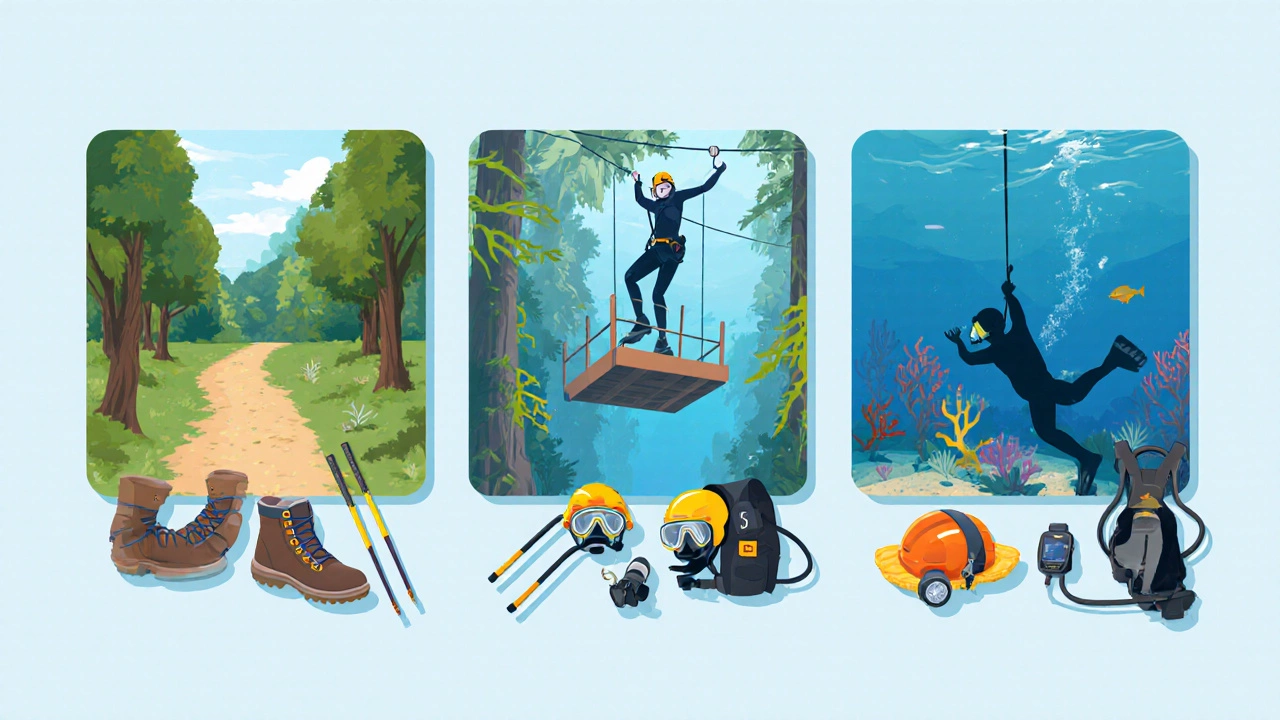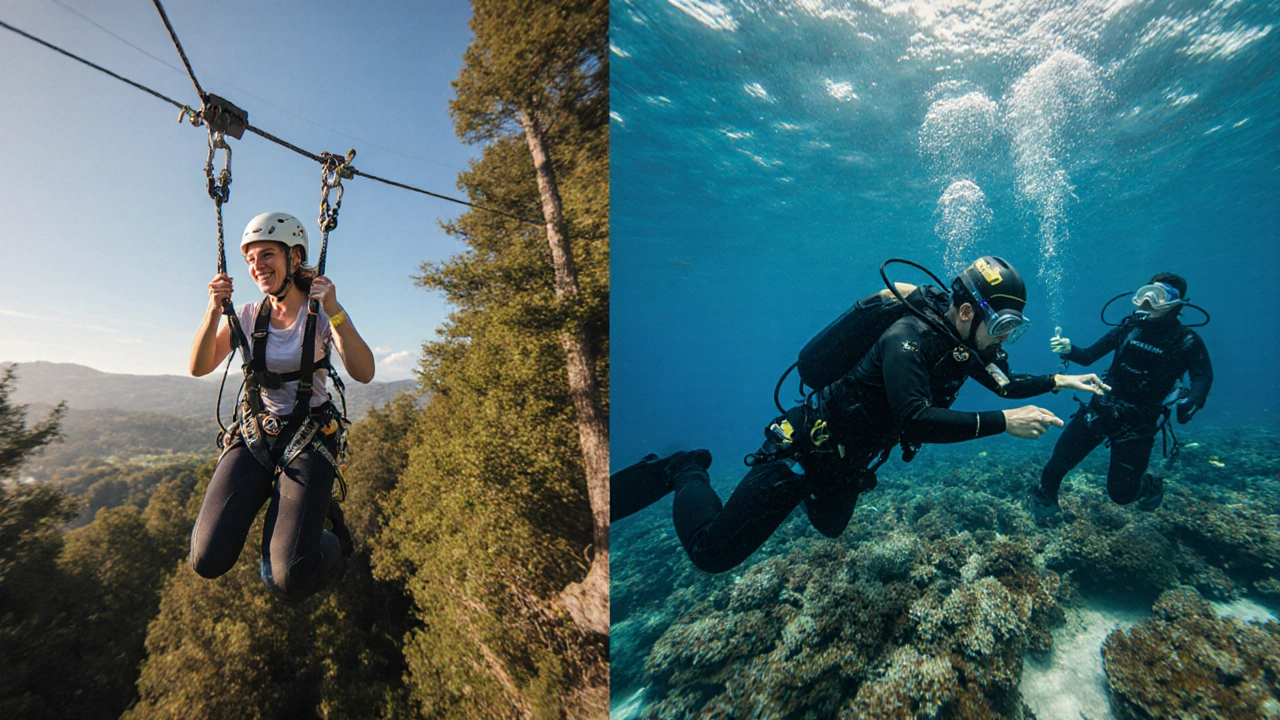Discover the Safest Adventure Sport for Thrill‑Seekers

Safe Adventure Sport Selector
Recommended Adventure Sport
Why This Sport?
Comparison Table
| Sport | Injury Rate (per 1,000) |
Training Needed | Avg Cost per Session |
Accessibility |
|---|
Key Takeaways
- Safety is measured by injury rates, required training, and equipment standards.
- Hiking, ziplining, and scuba diving rank among the lowest‑risk adventure sports.
- Choosing the right sport depends on your fitness level, fear tolerance, and access to qualified guides.
- Invest in proper safety gear and certified instruction to keep risk to a minimum.
- A quick comparison table helps you match a sport to your comfort zone and budget.
When you hear "adventure sport" you probably picture cliff‑jumping or high‑speed rafting. But not every adrenaline‑pumping activity carries the same danger. If you love the outdoors but prefer to keep serious injuries off the table, you need a clear picture of which sports truly sit on the safer side of the spectrum.
Adventure sport is any activity that combines physical exertion with a degree of risk, usually performed in natural environments such as mountains, rivers, or open skies. Safety hinges on three main factors: the inherent risk of the activity, the quality of training and equipment, and how well the environment is managed.
How Experts Measure Safety
Researchers and governing bodies look at three core metrics:
- Injury rate - number of incidents per 1,000 participants per year.
- Fatality rate - deaths per 100,000 participants.
- Required certification - level of formal instruction needed before solo participation.
A 2023 study by the International Adventure Sports Federation (IASF) compiled data from 12 countries. The average injury rate across all adventure activities was 1.8 per 1,000 participants, but it varied dramatically-from 0.2 for guided hiking to 5.6 for extreme base jumping.
Top Low‑Risk Adventure Sports
Below are the sports that consistently posted the lowest injury and fatality numbers while still delivering a solid thrill.
Hiking is a low‑impact activity that involves walking on trails, often in mountainous or forested areas, and can be scaled from easy day‑trips to multi‑day treks. Because it relies mainly on foot gear and basic navigation, the injury rate hovers around 0.2 per 1,000 participants-one of the lowest in the adventure sector.
Ziplining is a rope‑suspended ride that carries participants from one platform to another, typically at heights of 30-200 metres. Modern ziplines use redundant cable systems and automatic braking, resulting in an injury rate of about 0.4 per 1,000 participants.
Scuba diving is an underwater activity where participants use a self‑contained breathing apparatus to explore marine environments. When performed with certified instruction and proper gear, the injury rate stays near 0.6 per 1,000 participants, and most incidents are minor decompression sickness.
Paragliding is a free‑flight sport where a pilot launches from a hill or mountain using a fabric wing, relying on wind currents for lift. While the visual thrill is high, advances in wing design and mandatory pre‑flight checks have driven the injury rate down to roughly 1.1 per 1,000 participants.
Rock climbing is a vertical or over‑hanging ascent using hands, footholds, and safety ropes or protection devices. Indoor climbing gyms have lowered the overall injury rate to about 0.8 per 1,000, though outdoor sport climbing can climb to 2.0 depending on terrain.
White‑water rafting is a group activity that navigates rapid rivers in an inflatable boat, guided by a professional pilot. When run with a certified guide, the injury rate is close to 0.7 per 1,000 participants, making it comparable to scuba diving.

Quick Comparison of Low‑Risk Sports
| Sport | Injury Rate (per 1,000) | Typical Training Needed | Average Cost per Session | Accessibility |
|---|---|---|---|---|
| Hiking | 0.2 | Basic map reading | $0‑$50 | Very high (any trail) |
| Ziplining | 0.4 | Safety briefing | $30‑$120 | High (tourist parks) |
| Scuba diving | 0.6 | Open‑water certification | $70‑$200 | Medium (coastal sites) |
| Paragliding | 1.1 | Pilot license (2‑day course) | $100‑$250 | Medium (launch sites) |
| Rock climbing | 0.8 (indoor) / 2.0 (outdoor) | Intro class or gym membership | $25‑$150 | High (indoor gyms) / Medium (outdoor crags) |
| White‑water rafting | 0.7 | Guided session | $50‑$180 | Medium (river access) |
Safety Gear That Makes All the Difference
Across the board, the right equipment cuts risk dramatically. Below is a quick cheat‑sheet of essential gear for each sport:
- Hiking: sturdy boots, trekking poles, layered clothing, first‑aid kit.
- Ziplining: certified harness, helmet, double‑rope system (provided by operators).
- Scuba diving: regulator, buoyancy control device (BCD), dive computer, wetsuit.
- Paragliding: certified wing, harness with reserve parachute, variometer.
- Rock climbing: dynamic rope, helmet, carabiners, quickdraws or cams.
- White‑water rafting: personal flotation device (PFD), helmet, waterproof dry bag.
Investing in gear that meets international safety standards (e.g., UIAA for climbing, CE for diving) is non‑negotiable. Even the safest sport can become hazardous with sub‑par equipment.
Choosing the Right Sport for You
Answer these quick questions before you book your next adventure:
- How physically fit are you? Hiking and ziplining demand moderate stamina, while scuba diving requires swimming ability.
- Do you have a fear of heights? Paragliding and ziplining involve high elevations; you might prefer ground‑based options.
- What is your budget? Hiking can be virtually free, whereas a scuba certification runs into the hundreds.
- Is a certified guide essential for you? Some sports (white‑water rafting, ziplining) are almost always run by professionals.
- Where will you travel? Coastal destinations favor scuba, while mountainous regions open up hiking and paragliding.
Match your answers with the comparison table above, and you’ll land on a sport that feels exhilarating yet stays within your comfort zone.

Real‑World Stories That Show Safety in Action
Claire, a 34‑year‑old graphic designer from London, wanted a weekend thrill without risking a broken leg. She signed up for a guided zipline tour in the Lake District. The operator performed a double‑check of the cable system, gave a concise safety briefing, and provided a full‑body harness. Claire completed three lines, each 150 metres long, and walked away with no scratches-just a rush of adrenaline.
Meanwhile, Raj, a 27‑year‑old software engineer from Bangalore, pursued his love of the ocean through an open‑water scuba course in Phuket. After two days of classroom theory, he practiced in a pool, then progressed to a shallow reef under a certified instructor. His dive computer logged a smooth ascent, and the dive was recorded as “no‑incident”. Both stories highlight how structured training and proper gear keep risk low.
When Risk Is Unavoidable-How to Mitigate It
Even the safest sports carry some inherent danger. Here’s a quick mitigation checklist:
- Always verify the credentials of guides and instructors (look for certifications like PADI, UIAA, or national paragliding bodies).
- Check equipment for recent service dates; replace worn harnesses, ropes, or regulators immediately.
- Monitor weather forecasts; high winds can turn a scenic paragliding flight into a hazardous situation.
- Carry basic first‑aid supplies and know how to use them.
- Purchase travel insurance that covers adventure sports; read the fine print to ensure your chosen activity is included.
Following these steps turns a potentially risky outing into a well‑managed adventure.
Bottom Line
If you’re hunting for the safest adventure sport, start with hiking, ziplining, or scuba diving-activities backed by low injury rates, clear training pathways, and widely available safety gear. Pair your choice with certified instruction, invest in quality equipment, and always respect the environment. With those pieces in place, you can chase thrills without sacrificing safety.
Frequently Asked Questions
What makes an adventure sport safe?
Safety hinges on three pillars: low inherent injury rates, strict equipment standards, and mandatory training or certification before solo participation.
Is ziplining really low‑risk?
Modern zipline parks use redundant cables, automatic brakes, and daily inspections, driving the injury rate to under 0.5 per 1,000 participants-one of the safest thrill activities.
Do I need a license for scuba diving?
Yes. Most reputable dive centers require an Open Water certification (about 2‑3 days of training) before allowing independent dives. The certification reduces risk dramatically.
Can beginners try rock climbing safely?
Indoor gyms offer beginner walls with auto‑belay devices, making the sport safe for newcomers. Outdoor climbs require a partner and proper gear, raising the risk slightly.
How much should I budget for a safe adventure experience?
Budget varies: hiking can be free, ziplining $30‑$120, scuba certification $150‑$300, paragliding $150‑$400 for a tandem flight. Always add extra for safety gear and insurance.